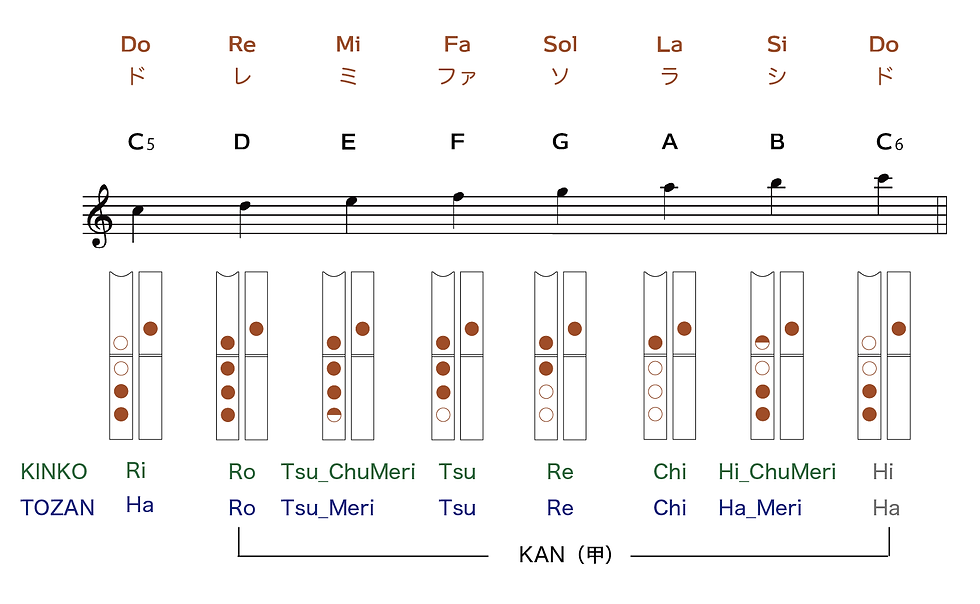Let's play "Do Re Mi Fa Sol La Si(Ti) Do" in C major!
- Faber Corporation /株式会社 ファベル
- Oct 12, 2024
- 4 min read
Updated: Oct 21, 2024
Tips for playing Do Re Mi Fa So La Si Do on the Shakuhachi No.2 INDEX >
(Note)
The length of the shakuhachi used here is the standard 1.8 (D) tube. In the following commentary, it is described as a 1.8 tube.
Do Re Mi Fa Sol La Si Do in the diagram is a relative pitch: a moving Do (starting from the Do in accordance with the key).
In contrast, absolute pitches are written with capital Roman letters, such as C D E F G A B C.
In the diagram, shakuhachi sound names (fingering) are written in roman characters. For exemple, Ro Tsu…
The two major schools of shakuhachi, KINNKO and TOZAN, sometimes have different fingering names for the same note. For example, the fingering of “Ri” in the Kinko and “Ha” in the Tozan are the same (the pitch is also the same), only the way they are called is different.
The fingering of the shakuhachi (Ro Tsu Re...) also indicates the pitch of the note, but this pitch is relative. For example, “Ro” is D for a 1.8 tube, C for a 2.0 tube, and E for a 1.6 tube.
The first octave

Figure1: Fingering chart for the first octave in the C Major Scale
*C4 means the fourth C from left on a standard 88-key piano keyboard (Middle C)
Regardless of the length (key) of the instrument, the range from «Ro»: Tsutsune-tone (the lowest note produced with all five holes closed and without MERI/KARI) to «Ri/Ha» is called OTSU.
Do (C4) → This note is outside the range of the 1.8 tube (D_tube). See Note1.
Re (D) → «Ro»: Tsutsune (the lowest note produced with all five holes closed and without MERI/KARI) 。First note of the basic five tones.
Mi (E) → «Tsu ChuMeri» (KINKO) / «TsuMeri» (TOZAN): This note is not included in the basic 5 notes. You make it by closing 1/2 on hole no.1. You do a little MERU at the same time the hole is 1/2 closed. This is a Half tone MERI (F♭=E) of «Tsu» (F).
Fa (F) → «Tsu»: Second note of the basic five-notes.
Sol (G)→ «Re»: Third note of the basic five-notes.
La (A)→ «Chi»: Forth note of the basic five-notes.
Si (B)→ «Ri_ChuMeri» (KINKO) «Ha_Meri» (TOZAN): Not included in the basic five notes. You make it by closing 1/2 on hole no.4. You slightly do MERU at the same time the hole is half closed. This is Half tone MERI (C♭=B) of «Ri/Ha» (C).
Do (C5) → «Ri/Ha»: Fifth note of the basic five-notes.
( Note 1.)
Do (C4) is called “Ro-Omeri” as a sound name for the shakuhachi. When viewed from “Ro” = D, it is the pitch of “whole tone Meri ” and is in fact indispensable for the performance of Honkyoku (classical piece). This sound is produced by increasing the degree of meri action while keeping the fingerings in “Ro” (closing all five holes). However, it is quite difficult to lower the pitch accurately and to make it sound decent. It would take a lot of time to learn. For more information on how to play “Ro-Omeli” (C4) and Honkyoku, refer to the DVD “The SHAKUHACHI for BEGINNERS narrated in six languages” and other DVDs.
Aside from Honkyoku, first, notice that the first “Do” in C major scale on the 1.8 tube, is not C4, but C5, or a 2-octave “Do” (Kotoko's “ Ri” and Tozan's “C”).
The second octave

Figure2: Fingering chart for the second octave in the C Major Scale
*In the KINKO school, the note one octave above the «Ri» is called «Hi».
*Regardless of the length (key) of the instrument, the range from «Ro» as one octave above the Tsutsune to «Hi/Ha» is called KAN.
Do (C5)→ «Hi» (KINKO) / «Ha» (TOZAN)
From Re (D) to Si (B) → Fingerings are the same as for the first octave.
*With the same fingering, a note one octave higher can be produced if the flow of the breath is faster than when playing in the OTSU range.
In the KINKO, the note (fingering) one octave above «Ri_ChuMeri» is called «Hi_ChuMeri».
The third octave

Figure3: Fingering chart for the third octave in the C Major Scale
*Regardless of the length (key) of the instrument, the range above «Gono_Ha» (KINKO) /«Pi» (the note two octaves above Tsutsune) is called the TAIKAN.
*When playing the range TAIKAN, the highest note that can be used in practice is usually «Re_Taikan». There are other ways to achieve even higher tones, but they are omitted here.
Do (C6) → «Hi» (KINKO) / «Ha» (TOZAN).
Re (D) → «Gono_Ha» (KINKO) / «Pi» (TOZAN). Do MERU with no.5 hole slightly open to produce a steady sound. The pitch is two octaves above Tsutsune.
Mi (E) → «Shino_Ha» (KINKO) «Shi» (TOZAN).
Fa (F) → «Tsu_Taikan» The third octave F (Fa in C major) cannot be played on a standard shakuhachi. If you play the TAIKAN range with the «Tsu» fingering, the 1.8 tube will naturally sound a half tone higher pitch: F-sharp instead of F.
Sol (G) → «Re_Taikan» This note can be produced by blowing even faster than when playing in the KAN range, however some instruments may have difficulty producing this note.
Next step
Once you have confirmed the C major scale, next try to play a key other than C major.
→ Article "Let's play three diatonic scales of Flat system:F major, B-flat major, E-flat major"


Comments